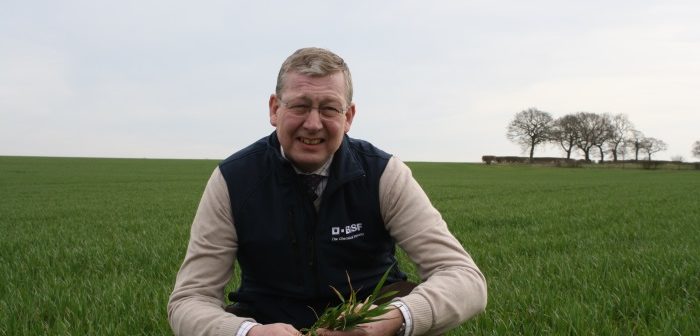There is a huge increase in the area of spring barley in the ground in England this year, with estimates suggesting close to 1 million hectares of the crop have been sown, the highest area for over 30 years. A wet autumn and winter meant growers in England had to abandon plans to drill winter crops and have instead switched to spring planting.
Ben Freer BASF Business Development Manager UK says, “Although much spring barley is being grown under duress this year it does not have to be the poor stand-by crop.” A BASF survey has found that over 80% of English growers will have some spring barley in the ground and Mr Freer said, “ We have some really good crops out there; planted in good order which have come through quickly . Yield average in the UK is 7 – 8 t/ha but it is possible to get significantly higher yields with increased inputs.”
North Norfolk and the South Downs are the areas where spring malting barley is traditionally grown in England, on light soils. Mr Freer says, “It is likely we will see malting barley grown outside of these traditional areas due to circumstance this season and where growers are not used to the crop it will be more of a challenge. Achieving a malting standard, particularly on stronger land, could well be problematic so going for yield and the feed market would be a safer option.” Mr Freer says, “Our key diseases are Ramularia and Net Blotch, which can give yield losses of up to 1.0 t/ha and 2.0 t/ha, respectively. Crop conditions remain stressed for the moment, giving increased risk of Ramularia infection.
Typically, an English spring barley fungicide programme will be prothioconazole and pyraclostrobin based at T1, at GS 30-31, to control Mildew, Net Blotch and Rhynchosporium. For T2, at GS 45-59, an efficient programme would include Revystar®XE (Revysol® + Xemium®), and pyraclostrobin to protect against Brown Rust, Net Blotch and Ramularia.
In Scotland, the area has only slightly increased retaining the crop’s position as the most widely grown cereal with over 250 kha planted. Scotland’s main spring barley growing area is on the eastern seaboard, however, a lot of mixed hill farms also grow spring barley, for straw. 60% of the barley grown is for the malting market, with the remainder for feed, some of which is exported.
Scotland is also dry, says BASF Agronomy Manager, Scott Milne. “Dry conditions are prevalent and there is evidence that the foliar symptoms of Ramularia are more apparent in crops that are stressed by drought conditions,” he says. He adds that the loss of chlorothalonil (CTL) will be keenly felt because, as well as being a very useful tool for resistance management, it was best for Ramularia control. “However, Revystar® XE has good efficacy on Ramularia and brings us some way back to having good control.”
Fiona Burnett SRUC Professor Applied Plant Pathology said, “Barley is a tricky crop with a history of slow uptake of the more disease resistant varieties and growers are dealing with multiple disease targets. There is quite a baggage of resistance problems, which makes our selection of fungicides particularly acute, growers have to be quite clever to manage that situation, however, there is chemistry available. The arrival of Revystar® XE this year is particularly welcome in moving us forward. It’s good news for barley as it brings a new azole, Revysol® and a strong SDHI, Xemium®.” Prof. Burnett said, “CTL was best for Ramularia control so will be a big loss, however, Revystar® XE has good efficacy and brings us some way back to having good control. The final cut off for malting/brewing market is at the booting stage, GS 45. Spring barley grows so quickly there is often less than a fortnight between the T1 spray and the booting stage so that will need very careful positioning. For feed crops the cut off is later, at GS 69.
We have seen in trials that minimising stress to the crop in some way helps to decrease the level of Ramularia so that may be how we look to manage the disease going forward.”
Mr Milne said, “now that CTL can no longer be used Revystar® XE will be the best product on the market for controlling Ramularia which in turn leads to a reduction in brackling. Xemium® also increases the thickness of all the internodes on the stem, making the stem stronger, allowing heavier heads to be carried without brackling.”
Mr Milne adds that: “There appears to be a link between Ramularia and brackling and so its formulation with Xemium®with its acknowledged activity on brackling gives superb complementary activity.
“My fear is that summer rainfall, if and when it arrives, will result in a rapid spurt of growth in barley crops currently starved of moisture. This growth will be relatively weak and so the crop will become more susceptible to brackling as a result. As well as effectively controlling disease, fungicides containing Xemium® have proved over many years to reduce brackling and necking in barley. With a much larger area of spring barley in the ground this season harvesting at the correct time may prove difficult.”
Delayed harvest exacerbates head loss in barley and strengthening the straw will mitigate this symptom.




